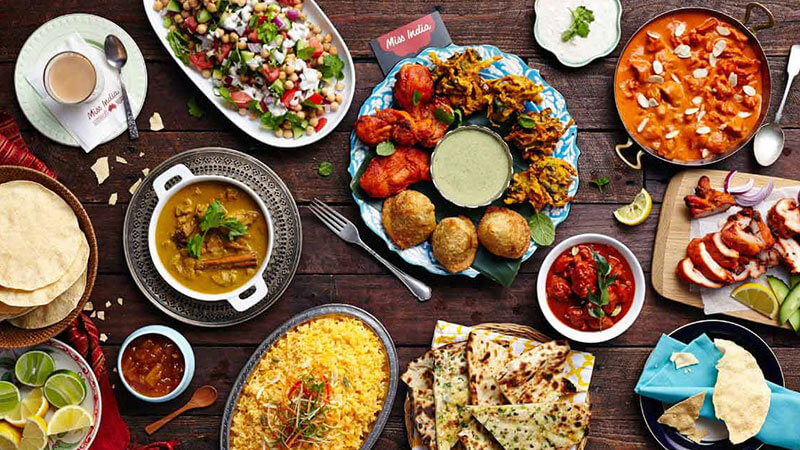Kashmir is famous as ‘heaven on earth’ but more than its scenic beauty, it also has a distinct cuisine that tastes different. Kashmiri cuisine enjoys deep-rooted traditions complemented by the region’s rich agricultural resources which include spices, herbs, meat, and vegetarian elements that have been refined over generations of practice. Ranging from the light and warm flavors of saffron-laden dishes to the thick curry styles of traditionally cooked lamb meat, the cuisine of Kashmir is a true reflection of the environment and culture that the region was able to develop over time.
The Essence of Kashmiri Cuisine
Persian, Afghan, and Central Asian aspects to flavors as well as Indian spices and cooking skills have all been combined in Kashmiri cuisine. The weather of the area is chilly so food is created that offers heat and comfort. Spices are commonly used in Kashmir including cinnamon, cardamom, and cloves which make food spicy and aromatic.
Wazwan is exclusive to the people of the state as it includes multi-course meals which is the highest form of cuisine in the region. It is served mainly during weddings and special occasions. Wazwan is a complex feast with around 36 dishes containing a variety of meat and are prepared by Wazas who are master chefs after years of rigorous training.
Foods from Kashmir: Signature Ingredients and Staples
Kashmiri cuisine today is rich and filled with local produce which includes greens such as haakh (Kashmiri spinach), red cabbage, and turnips. Certain types of vegetables that grow in the valley’s unique soil and climatic conditions possess unique taste. An additional starchy ingredient is basmati rice, of which many come from the fertile paddy fields of the region as the base for various traditional foods.
In addition to rice, meat, mainly lamb and mutton, is an essential part of Kashmiri food, which is flavored with many spices and cooked for long periods of time until the meat becomes tender. Substantial lamb dishes include Rogan Josh (a lamb-very red sauce curry) and Gushtaba, which is a meatball curry with strained yogurt that is seasoned.
Dry Fruits from Kashmir: The Golden Delicacies
High-quality dry fruits from Kashmir region have a place in food and economy both, which gained immense popularity. The dry fruits from the region include the following: – almonds, walnuts, and dried apricots. While Kashmir almonds are sweet with a high oil content, walnuts, which are known to be the finest in the world, are consumed in confectionery, snacks, main courses, and others.
The region grows saffron as well, called Kashmiri Kesar, and it stands to be one of the costliest spices in the international market. Saffron is used in preparing aromatic saffron rice with nuts and fruits in Kashmiri Pulao and is used in traditional teas, adding color, fragrance, and exclusive taste to the foods. Other dry fruits like pistachios and dried cherries are also used, making the delicacy Phirni (rice pudding) rich and sweet.
Iconic Kashmiri Dishes
– Rogan Josh: This signature dish, lamb curry encapsulates all spices blended into it along with clove, cardamom, and fennel, resulting in a bright red color and rich flavor.
– Dum Aloo: A nice dish, Dum Aloo is about baby potatoes which have been enriched with the flavor of yogurt and Kashmiri chili powder, which lightens the taste a little but also provides a deep and warming flavor.
– Kahwa: A traditional drink, Kahwa is one that warms the heart. It is made from Kashmiri green tea, which is enriched with spices such as saffron, cinnamon, and cardamom and topped with pieces of almonds or walnuts.
– Kashmiri Pulao: A spiced and fragrant rice casserole studded with saffron and dried fruits, it can also come alongside vegetables or meats.
The Impact of Natural Foods in Kashmiri Cuisine
The practice of using natural, locally available ingredients is a fundamental characteristic of the Kashmiri kitchen, and a balanced relationship between the natural ingredients and degrees of silly elaborate dishes is put forth. Ranging from dried fruits to several exotic spices, each and every ingredient is comprehensively selected and placed in order to enhance the quality of each separate dish. This type of cuisine is a true witness to the history, culture and farming way of life in Kashmir and hence the experience is unparalleled to anyone around the globe.
The taste of great food prepared during an elaborate Wazwan meal or during a simple get-together of family members is a sight that allows one to experience the feel of warmth and the charm of heaven placed on earth.
Conclusion
Kashmiri cuisine is the product of nature, culture and art. The Kahwa, where saffron is added to water, and the Rogan Josh, where meat with spices dominates, have the distinct characteristics of the region’s spices, dried fruits and vegetables. Not mere food, but a celebration through the generations which have refined it further as well. These are the hills of Kashmir and the dishes made there are all rich in ingredients from the community, the traditions and the land. It is this amalgamation that makes Kashmiri food warm and mouth-watering. It indeed stands true to the lush and pure beauty of Kashmir and its indomitable spirit, and now forms an important facet of the cuisine of India.






